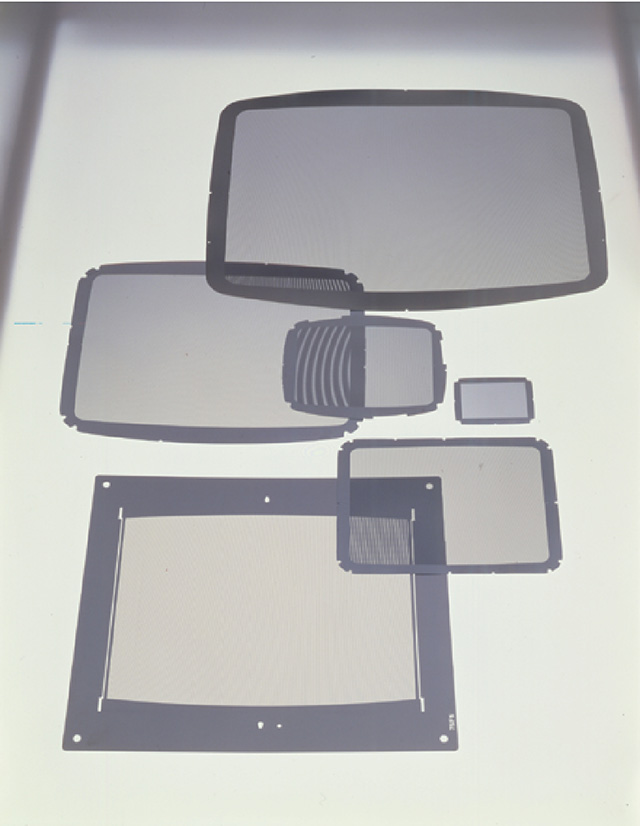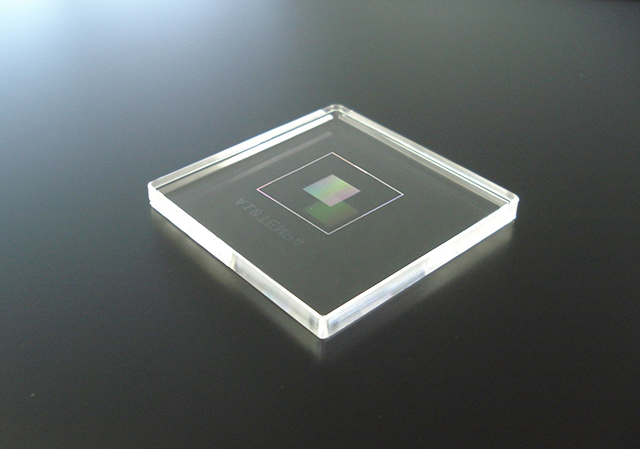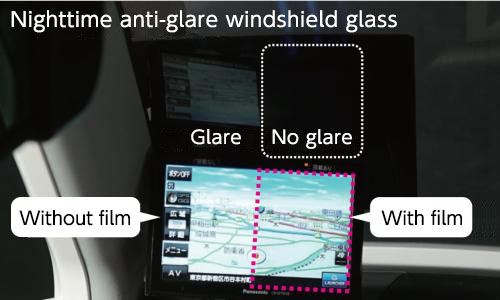Microfabrication : Origin and Development
A technology for making printable stamp seals leads to the production of 200,000-hole plates for Japan’s first color televisions

In the early 1950s, with the aim of facilitating the shift from black-and-white to color televisions, DNP proceeded to develop a metal component called a shadow mask that could display color images. An essential part of a cathode ray tube, a shadow mask has a vast number of cone-shaped holes for allowing electron beams to pass through to a metal plate. At first, however, despite the efforts of various companies to develop shadow masks, it was not possible to mass produce them through machine processing.
Meanwhile, DNP was refining its techniques for producing printing plates with the goal of realizing even clearer and more vivid printing. As those techniques were developed, DNP advanced its high-precision microfabrication technology, such as processing metal through etching. By applying these technologies, DNP was able to successfully produce shadow masks as a viable product.
The array of ultra-fine holes on a shadow mask allow electron beams to be precisely exposed on each of the television’s RGB output devices. In order to accurately display colors, the holes must be formed with different directions and shapes based on a precise understanding of the properties of light. Following a process of trial and error, DNP succeeded in producing about 200,000 holes of 0.3 millimeters in diameter on a 17-inch metal plate (26 centimeters tall by 35 centimeters wide) with a thickness of 0.15 millimeters. That paved the way for the manufacturing of color televisions in Japan.
DNP continued to refine its microfabrication technology, and in 1959 the Company successfully produced a prototype of a photomask, the master for forming semiconductor circuits. This achievement enabled Japanese manufacturers to make electronic goods smaller and thinner during the country’s period of rapid economic growth in the 1960s and 1970s. Having led to the creation of countless products, DNP’s microfabrication technology has continued to evolve up to the present day.
Nanoimprinting solutions
From designing ultrafine patterns to utilizing them for mass production, DNP has driven the advancement of many different products.
Integrating three printing technologies—pattern stamp seal production, molding, and optical design

DNP possesses a technology for producing patterns used to make printing stamp seals, and a molding technology for transferring uneven shapes at the nano-level from templates to resins. The Company has also been at the forefront of optical design technology, a position it attained by developing a wide range of display-related products. For example, DNP has applied its expertise in controlling light to ensure the uniformity of display backlighting in large-screen televisions and other products, and to bend light so a display is viewable only by the user. By combining such technologies, DNP has leveraged its ability to manufacture products with nano-size forms and offer them as nanoimprinting solutions.
Total support from consulting to mass production
DNP’s technical expertise includes nano-size pattern production technology, high-precision molding technology, materials selection, prototype verification and all of the technology needed for developing products and mass producing them. DNP can consistently ensure uniform production at the nano-level, allowing its customers to produce products without their own nano-technology or mass production facilities. DNP is also taking on the challenge of mass producing high-precision patterns on large surfaces. On such a large surface, it is extremely difficult to form nano-size shapes uniformly with near zero measurement error. Nevertheless, DNP has advanced technological capabilities for mass-producing components for large high-resolution displays, and by leveraging that competitive advantage it is taking the lead in the nanoimprinting industry.
Exploring the possibilities of nanotechnology in an uncharted industry
DNP is making use of its technology for controlling the amount of light on a targeted spot and expects to apply it to iris recognition and other related techniques in the future. Because sensors can now be deployed in such small areas, built-in sensors may become increasingly common. Sensors can be used in vehicles for detecting the movement of people and in household appliances for recognizing user’s gestures. They can also be used in self-driving vehicles. Since nano-size objects are even smaller than germs in the air, it is possible to imagine advancements in medicine through the application of nano-technology. With that in mind, DNP’s researchers and developers are working to develop completely new product lines.
DNP’s viewing angle control film
Controlling light and eliminating reflected glare to promote safe driving and user-friendly automobile displays, while expanding globally
The wealth of printing technology behind the development of viewing angle control film

One of DNP’s strengths is its development and production of optical films that control light. For example, its films for lenticular lenses used in consumer-use large-screen rear-projection televisions, which are popular in Europe and North America, ensure that light is uniformly projected so that vivid images can be viewed from any angle.
The application of this light-controlling technology makes it possible to utilize the reflection of light so that images cannot be seen from certain angles, like the privacy protection film used on the screens of mobile devices. Similarly, it can make the display of a car navigation system viewable only by the driver of the automobile. It is now possible to produce viewing angle control films capable of all of these varied functions.
If viewing angle control film is adopted, more options will be available for the placement of liquid crystal displays inside automobiles, opening up all-new possibilities for automotive interior design beyond the conventional models of the past.
DNP intends to increase the functions of its viewing angle control film and contribute to safer driving while expanding globally. Further, it will initiate new trends in the automobile industry by leveraging unique competitive advantages in technology and manufacturing derived from expertise in printing.
Printing technology expansion and enhancement